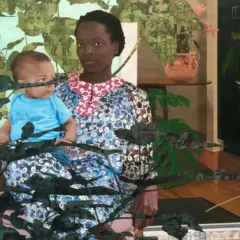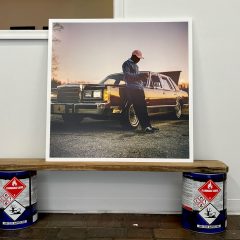[Rachel visits an exhibition featuring the work of three artists whose Harlem neighborhoods inform their work. — the Artblog editors]
A residency for any artist is a time to reflect. Invited into a new space, setting, and sense of pace, the artist is given the opportunity to foster his/her artistic process, while actively exploring a new community. Since 1968, the Artist-in-Residence program at The Studio Museum in Harlem has been enabling visual artists of African and Latino descent to do just that–explore themselves, and explore Harlem.
Neighborhood influence
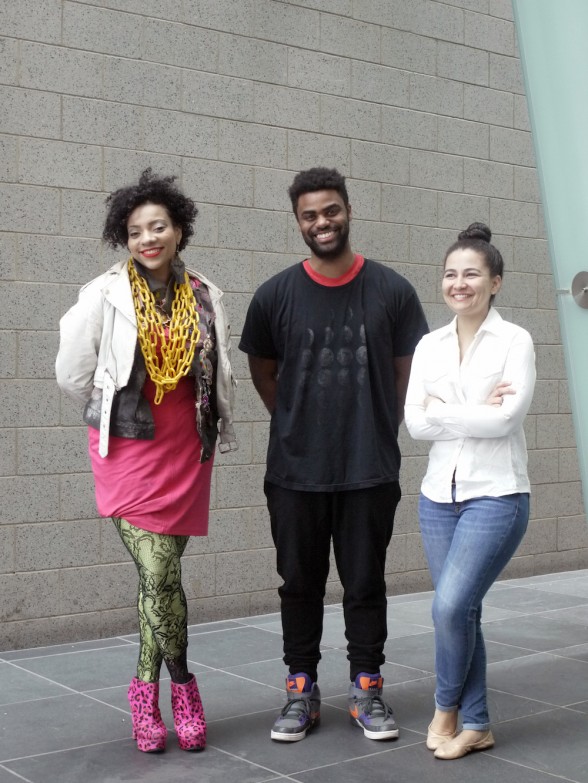
Material Histories, on view at The Studio Museum through October 26, 2014, features the institution’s 2013-14 Artists in Residence: Kevin Beasley, Bethany Collins and Abigail DeVille. While each artist draws from his/her distinctive style and point of view, the three find harmony in their manipulation of materials and interpretations of regional histories.
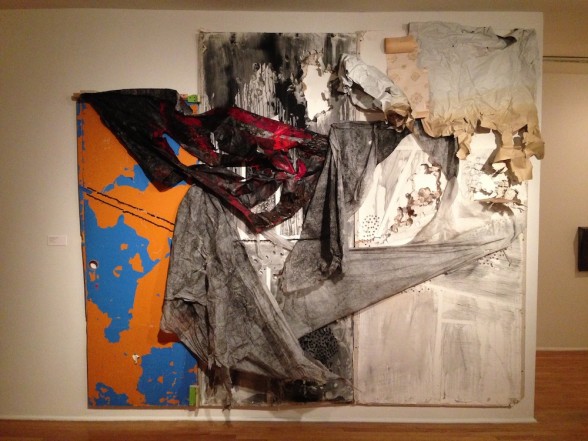
Abigail DeVille boldly announces her vision with her large-scale piece, “Harlem Flag”. White and black mixes with gray, as pops of blue, orange, and red come together in a solid mass struggling to find cohesion. The work combines impressions of peeling wallpaper and tattered curtains–the artist manipulates materials that could be found in an abandoned home or a rundown auto shop. Tension imbues the piece. With each material twisted and pulled and crumbled and distorted, “Harlem Flag” becomes a testament to the community’s historical past and its present reality. Texture becomes a metaphor for multiplicity, a reflection on Harlem’s ever-changing demographics and, perhaps, sense of prosperity or ownership. The piece is a statement–a reflection on place that contemplates everything from the firmness of Harlem’s sidewalks to the uncertainty of its future.
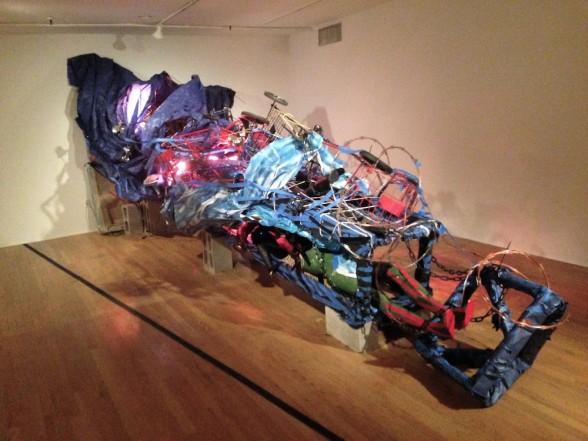
A constructor of overlooked histories, DeVille finds narratives in the detritus of the everyday. This talent is celebrated in the artist’s large-scale installation, “ADDC Obelisk”. The work feels like a Harlem space ship–shopping carts, mannequins, barbed wire, and box springs come together to form a giant mass. DeVille rolls the momentum and energy of New York City’s streets into one compact form. Though playful, “ADDC Obelisk” can also be seen as dangerous– the familiar morphed into an unknown. Most importantly, however, the artist makes us look twice at these objects, regarding each as it would never be seen and reminding us of its potential for both unity and alienation.
Narrative sculpture
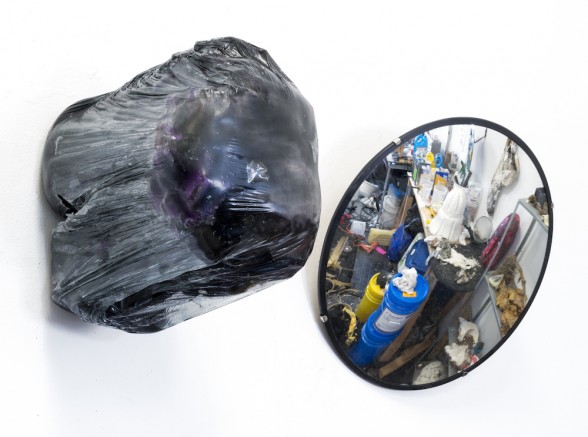
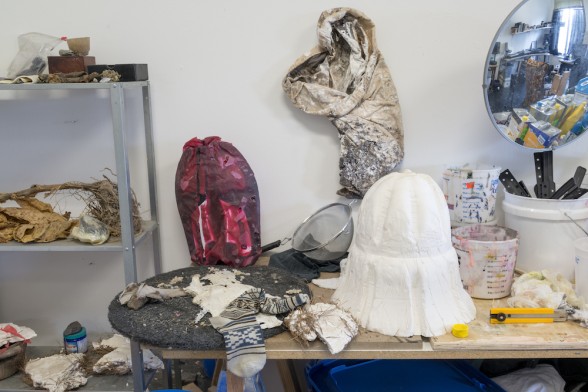
Kevin Beasley delivers more subtle works, but, like DeVille, sources his materials from the areas in which he lives and works. Using polyurethane to harden domestic readymades–dressing gowns, rugs, clothespins, cotton rags, etc.–Beasley takes the discarded and creates anew. “Untitled, 2013” is composed from a pillowcase and plaster. Creating the sensation of frozen movement, the artist infuses a sense of narrative into the carefully manipulated materials. In another work, “Untitled, 2014,” Beasley furthers his ability to pair the inanimate with narrative. Made out of shorts, a T-shirt, underwear, a cotton rag, and zip ties, the hardened sculpture stretches out from the wall like a fist pounding through plaster. Its striking dimensions create a sense of urgency that is at once arresting, but so familiar.
Language-based works
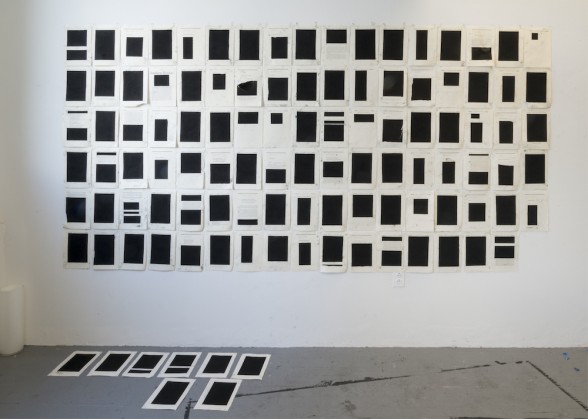
Bethany Collins offers a more conceptual approach than her fellow residents. Known for erasing, writing, and rewriting text, particularly from books and journals printed between 1950-1980, Collins is intrinsically concerned with language, race, and textual association. In “Southern Review,” Collins blacks out entire passages of the literary magazine with only the title and author’s name left legible. The viewer is left to engage this meager information and conjure his/her own imaginations of what a title or author might have meant. Stepping back from the work, the individual pages collectively create a startling geometric pattern in black and white – beautiful, indeed, but also cleverly emblematic.
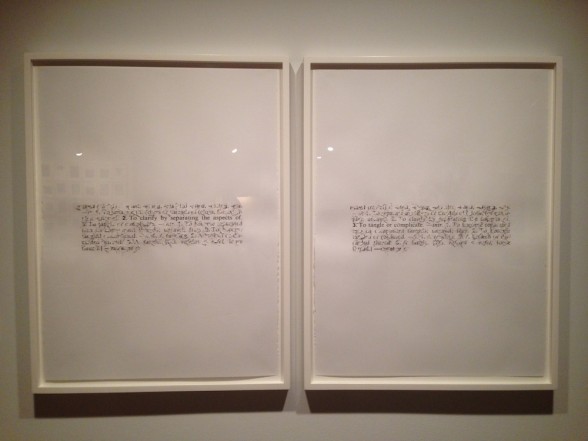
In two other works–“Skin, 1965,”and “Ravel, 1982,”Collins proves her brilliance at erasing. Definitions are methodically scoured away to leave only partial explanations that take on far deeper connotation. Hung side-by-side, the two works reflect back on one another to further complicate their meanings. Be prepared to linger on the words and contemplate their subtle cleverness for hours.
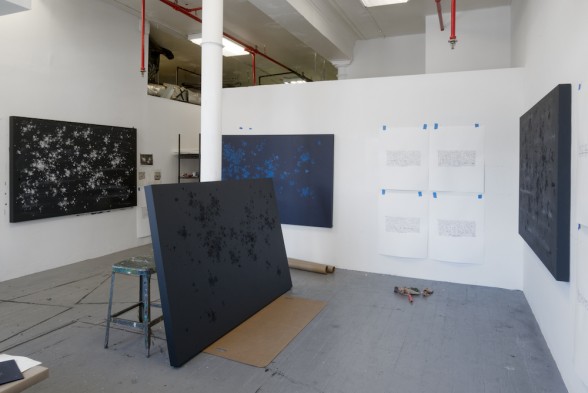
The artist’s successful understanding of pairing can also be seen in the pieces “She’s Trying to Fuck Her Way Into Blackness” and “He’s Trying to Fuck His Way Out”. Composed of blue colored pencil on black acrylic and wood panel, the works, from afar, conjure images of constellations. On closer inspection, we see that the blue markings are actually letters floating in and out of clusters, their meaning never defined, only reflective of the works’ titles. Once again, Collins manipulates language and its meanings through calculated decisions about what to reveal and what to erase.
Material Histories brings together three artists actively contemplating the question of the object and how its meanings are interpreted over time. Through material and contextual manipulation, the artists present a collection of work that speaks to individual understandings of history, race, identity, and culture, while focusing a wonderful collective gaze on contemporary Harlem.
Material Histories is on view at The Studio Museum in Harlem through October 26, 2014. The museum is located at 144 West 125th Street, New York, NY.



